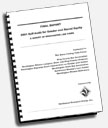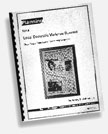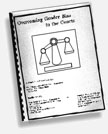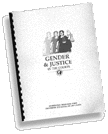| Juvenile Justice and Racial Disproportionality conference |
Task Force on Race and the Criminal Justice System – Juvenile Justice and Racial Disproportionality Conference March 28, 2012
|
| Becoming a High Performance Court |
Becoming a High Performance Court - The High Performance Court project is an effort by the National Center for State Courts to design a conceptual framework for administrative improvements in all courts.
|
| Federal Firearms Regulations Reference Guide, 2005 |
The Federal Firearms Regulations Reference Guide, 2005 provides information designed to help in compliance with all of the laws and regulations governing the manufacture, importation, and distribution of firearms and ammunition. Accordingly, it contains the relevant Federal firearms laws and regulations, some of which have changed since the 2000 edition. It also contains rulings, general information, and questions and answers to give you further guidance on the Federal firearms laws.
|
| Sexual Orientation Bench Guide (2008) |
The Sexual Orientation Bench Guide provides judicial officers with a point of reference for the particular ways that the law touches the lives of Gay, Lesbian, Bisexual, and Transgender persons in their courtroom.
|
| Protocol Project Template for Coordinated Response to Child Maltreatment and Domestic Violence (January 2006) |
In recent years, professionals who work in the field of domestic violence have recognized that there is a lack of common understanding among victim advocates, child welfare authorities, law enforcement, and the courts in dealing with the effects that domestic violence has on families. Problems raised by domestic violence are compounded by differing perspectives about how to address its impacts on families. It has become clear that discussion and resolution of these conflicting outlooks is essential to the common goal of protecting women and their children and stopping the generational cycle of domestic violence.
To address these issues, it is recommended that regional Judicial Leaders convene multidisciplinary groups to develop a written protocol for responding to domestic violence and child maltreatment cases.
Protocol Template for Coordinated Response
|
| Domestic Violence Manual for Judges (2006) |
The Domestic Violence Manual for Judges, 2006, is a product of the Washington State Supreme Court Gender and Justice Commission. The manual is an updated version of the Domestic Violence Manual for Judges, 2001, and is designed for two purposes:
1) To serve as a practical reference guide for judges and other court personnel; and
2) To serve as a textbook for judicial education in the area of domestic violence.
|
| The Hague Convention on International Child Abduction: A Child’s Return and the Presence of Domestic Violence (September 2005) |
This chapter discusses how the Hague Convention on International Child Abduction, and its enabling statute ICARA, have been applied in courts in Washington and around the country.
The chapter features an overview of the current law and addresses complex issues courts increasingly face when an abducting parent is also a victim of domestic violence seeking protection from American courts. The chapter includes citations to unpublished Washington cases to demonstrate how Washington courts have considered some of these issues.
As an emerging area of law, we hope this chapter will be useful and we look forward to making meaningful additions to the chapter as case law further develops in Washington.
A Child’s Return and the Presence of Domestic Violence
|
| Unintended Consequences: Removing Obstacles to Justice for Immigrants in the Courts, 45th Judicial Conference, October 2002. |
The purpose of this curriculum is to increase judicial officers' understanding of immigration related issues and promote the fair administration of justice by improving the courts response to non-citizens in Washington State courtrooms. The curriculum provides an overview of:
- How cultural and language issues affect non-citizens in court.
- How criminal pleas and sentencing impact a non-citizen's immigration and naturalization status.
- How judges can assist battered non-citizens petitioning for residency under amendments to the Violence Against Women Act.
This curriculum was adapted from Removing Obstacles to Justice for Immigrants: Educational Curriculum for Judges, a pilot program produced by the National Association of Women Judges. 1112 16th Street, NW, Washington, DC 20036, 202/393-0222,
 Introduction to the Unintended Consequences Manual Introduction to the Unintended Consequences Manual
 Table of Contents from the Unintended Consequences Manual Table of Contents from the Unintended Consequences Manual
 10 Suggestions to Removing Obstacles to Justice for Immigrants in the Courts 10 Suggestions to Removing Obstacles to Justice for Immigrants in the Courts
|
| The Glass Ceiling Survey

|
Conducted by the Northwest Research Group, Inc. the 2001 Self-Audit for Gender and Racial Equity was designed to answer the following question: Based on objective data, what is the status of women and minority lawyers in private law firms in the State of Washington?
View the Entire Report (3.5 MB) |
| Guidelines for Domestic Violence Protection and Antiharassment Orders (2001) |
The Guidelines for Domestic Violence Protection and Antiharassment Orders are available on the Domestic Violence Resource page.
|
| Washington State Parenting Plan Study (1999) |
The Washington State Parenting Plan Study examined parenting arrangements after dissolution of marriage. Work on the study began in late 1997, when Commission members framed a series of research questions focusing on the functioning of the Washington State Parenting Act. Dr. Diane Lye conducted the study and published the final report in June 1999.
|
| Domestic Violence Training for Judges in Rural and Tribal Courts (1998-00) |
Federal grant funding provided for development of this curriculum for a one-day training program for state and tribal court judges on domestic violence in the civil courts. Two new chapters for the Domestic Violence Manual for Judges will be complete in 1999. Audio tape and CD-ROM versions of the Manual were distributed to judges in 2000.
|
| Planning for a Local Domestic Violence Summit: Organizing a Coordinated Community Response (1998)

|
The purpose of this manual is to allow easy replication of the local domestic violence summit model - so more communities can use this approach to strengthen their efforts to effectively and comprehensively address domestic violence. The manual explains the structural steps required to plan and execute a successful summit and provides examples of formats, materials and products that can be customized for a community's use. A short video is available to accompany the manual.
|
| Annual Report of the Gender and Justice Commission of the Washington State Supreme Court (1998, 1997, 1996) |
See Annual Report Section.
|
| Domestic Violence Summit I - Final Report and Action Plan Status Report (1995)

|
This report describes the first Washington State Summit on Domestic Violence. The six-month follow-up report includes the action plans implemented by Summit participants. Hard copy available.
|
| Domestic Violence: Challenges and Solutions in Washington - Video (1995) |
This short video was prepared for and shown at the Domestic Violence Summit, 1995. It contains interviews with Washington State legislators, judges, service providers, victims and a batterer who discuss what they see as the challenges and solutions to the problems of domestic violence in our state.
|
| Overcoming Gender Bias in the Courts (1992) |
Workshop materials prepared for presentations to state court managers and at the annual conference of the National Association for Court Management.
|
| Gender Bias in the Legal Profession - Breaking the Glass Ceiling (1991-1994)

|
Workshop materials were prepared for Washington Women Lawyers & the Gender & Justice Implementation Committee.
|
| Domestic Violence Curriculum Manual (1991) |
A comprehensive Domestic Violence Curricula developed after conducting a need assessment of judges, court personnel, and advocates. Curriculum Manuals were distributed to constituent group Education Committees.
|
| Final Report of the Washington State Domestic Violence Task Force (1991) |
A one-year Domestic Violence Task Force was funded by the Legislature at the request of the Gender and Justicee Task Force. The Final Report of the Washington State Domestic Violence Task Force was distributed to state judges, the legislature, law enforcement, prosecutors, and domestic violence service providers.
|
| Report to the Washington State Legislature from the Spousal Maintenance and Property Division Study Group of the Gender & Justice Implementation Committee (1990) |
The study was conducted at the request of the Legislature at the recommendation of the Gender and Justice Task Force. The report was distributed to the state judiciary and legislators.
|
| Gender & Justice in the Courts - Final Report (1989)

|
The Final Report of the Washington State Task Force on Gender and Justice in the Courts contains findings and recommendations following two years of study. Chapters focus on the treatment of women in substantive law areas of family law, domestic violence, and sexual assault and the treatment of women in the court environment. Appendices contain the results of surveys of judges, attorneys, and domestic violence and sexual assault service providers. |







